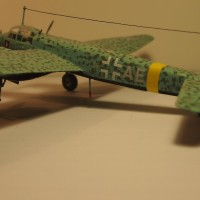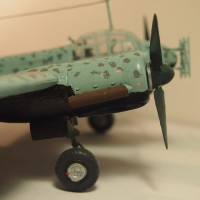Revell Junkers Ju 88 C-6 Z Nightfighter
From author:
It is my first article published on iModeler.com
It was my first kit after over 16 years of break from scale modeling (at that point in time I had no knowledge about modeling and had one brush, one glue and Revell paint can). I made it in 2016. The kit is from 2013 manufactured by Revell.
Technical Data:
Wingspan: 20.08 m (65ft 10ins)
Length: 14.36 m (47ft 1ins)
Height: 5.07 m (16ft 7ins)
Engines: 2x Junkers Jumo 211J
Power: 1410 Bhp
Empty Weight: 8100 kg (17857 lbs)
Max. Take-off Weight: 12460 kg (27470 lbs)
Maximum Speed: 510 km/h (317 mph)
Cruising Speed: 490 km/h (305 mph)
Landing Speed: 145 km/h (90 mph)
Normal Range: 2 950 km (1830 miles)
Service Ceiling: 8 800 m (28900 ft)
Armament: 3 x MG 17; 3 x MG 151/20; 1x MG 81Z
Crew: 3 - 4
During the Second World War, the Junkers Ju 88 embodied what the Euro Fighter, the Rafale and the F-22 represent in our day. The MRCA - Multi-Role Combat Aircraft. It served as a conventional high altitude bomber, a dive bomber and was just as effective as a night fighter or even a torpedo bomber engaging surface vessels. It could also be used as a tank killer and against railway targets, or even as a mine-layer or reconnaissance aircraft. During its final days it was used as the bomb-carrier in a composite unit under a Me 109 or Fw 190. The Ju 88 was still in full production at the end of the Second World War and up to this point in time more Ju 88's had been built than all the other Luftwaffe bombers put together - over 15000 aircraft. Designed and built as a fast bomber, the Ju-88 soon set the Worlds first Speed Record over a 1000 km (621 mile) course. In March 1938 it reached a speed of 517km/h (321mph) - a speed that fighter aircraft of the period could not achieve! Right from the beginning, the specification for the Ju 88 issued by the RLM (Imperial Aviation Ministry) included the roles of Daylight Attack and Heavy Night Fighter. The Attack version prototypes were the Ju 88 Z-15 and Z-19, which allowed for a nose armament whilst still retaining the glass fuselage front. The first production model was the Ju 88C-2 (based on the Ju 88A-1) with a metal nose to accommodate four cannon. The bombing equipment was only partially dispensed with. The first unit to receive the new aircraft was Fighter Wing 30 that had formed the first Attack Squadron during operations in Norway. With a range of over 2500 km (1550 miles) and excellent flight characteristics it was the ideal aircraft for General Kammhuber's newly established Night Fighting. The first unit in Holland to receive the new aircraft was the 2nd Night Fighter Wing in Gilze-Rijen to support their successful long range operations against British Bomber Bases. The following series, the Ju 88C-4 - was based on the Ju 88A-5 which in contrast to the A-1 had an extended wing and more powerful engines. The most prolific and indeed ultimate Ju 88-Attack/Night-Fighter was however the Ju 88C-6 (based on the Ju 88A-4) which was mainly deployed in Night Fighter units. As early as the end of 1942 the Ju 88C-6 - fitted with the FuG 202 Lichtenstein BC - was the first machine to have an on-board radar. When the improved FuG 212 Lichtenstein C-1 arrived, an on-board radar was finally available in large quantities. The Ju 88C thus became the Luftwaffe's most important night fighter and saw active service in all theatres of war from the Arctic down to Africa. The Ju 88C was however still used in the attack role in operations against ships in the North Sea and the Mediterranean, as well as on the Eastern Front in particular against railway targets. Production of the Ju 88C was stopped at the end of 1944 after a total 3964 of these aircraft had been built (source of information: Revell leaflet).

















Nice to have you in iModeler - you'll find it a healthy and helpful space to post your work. It's a great learning environment, and tagging along you'll see your techniques improve as you get back into the hobby! The Ju88 is a nice start, and it's in my favorite scale, so you can't go wrong with that! Thanks for posting, and keep it up!
Thank you for raising the spirit:) Best regards
Nice to see that it is "like riding a bicycle." 🙂
Welcome!
Thanks. More or less. With the age, I learned to be more patient, but dexterity suffers:).
Welcome to iModeler Lukasz. You sure pick a hard camouflage to go about using only a brush. Mottling with a brush, in any scale let alone 1/72 is s9mething I would never dare doing. Good job, keep going and have fun
Thanks, Actually I hadn't done it for a purpose. I went to only one hobby shop I knew and pick some random plane with the difficulty level of 5:) I had in mind that when I was a boy I did a plane with similar colors scheme.
Looks great. I'm doing a Heinkel 115 at the moment with a similar colour-scheme. I very much like these colours. I'm also interested in Axis planes. Look forward to your future builds.
Thanks. Currently, I am building Yokosuka D4Y Suisei form FineMolds. Today (due to Black Friday in one of the online shop) I bought Dornier Do Do 17Z - 7 From ICM. Wife will kill me, but what a heck:)
Beautiful work! Welcome - I am looking forward to many more builds, Lukasz!
Thanks. I will post two more of my previous builds and then Spitfire from our previous conversation will appear. It is due to saving the proper time series of my builds.